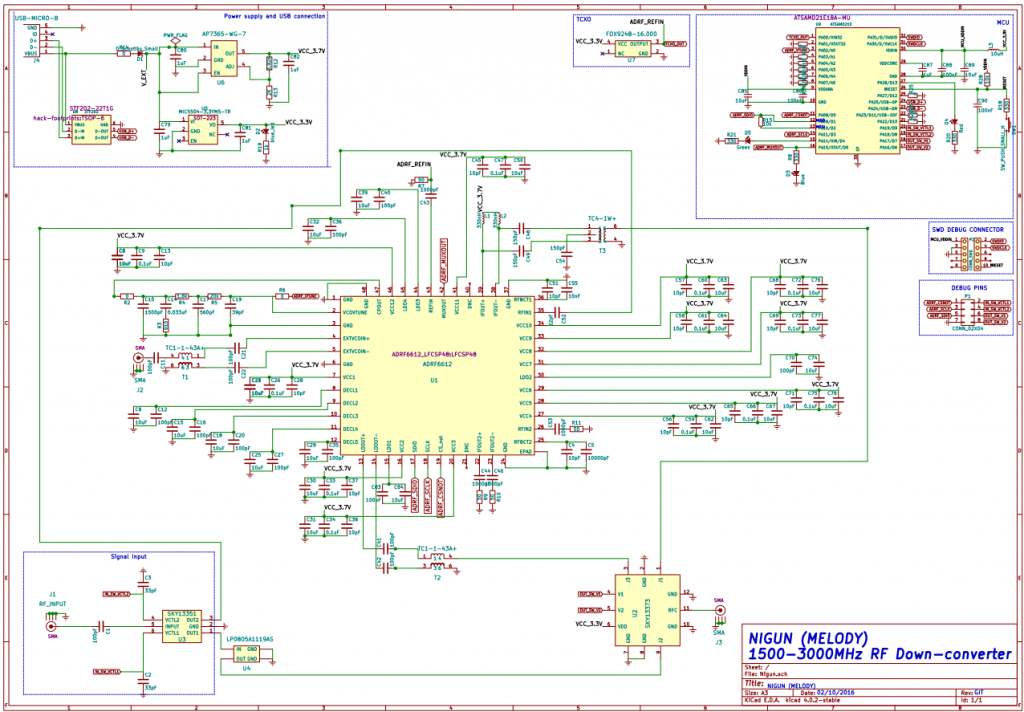Nigun (Melody): Open Hardware Plans for an RTL-SDR Downconverter
A downconverter is a circuit that allows the RTL-SDR to receive frequencies above its maximum frequency range of about 1.8 GHz. It works by converting all higher frequencies down into a lower frequency which can be received by the RTL-SDR. It is the opposite of an upconverter which is used to receive HF frequencies on an RTL-SDR. In the past the Outernet project was working on a commercial downconverter product for the RTL-SDR, but they had to unfortunately put an end to that project as the costs were not economical.
But now over on GitHub Raziel Einhorn has uploaded plans for his open hardware 1.5 – 3 GHz downconverter which is code named Nigun (Melody). Currently the design has just about been completed, and he is planning to order the first prototype this January. The main component appears to be the ADRF6612 RF mixer which is controlled by an ATSAMD21E18A ARM microcontroller. On the GitHub page he explains the main properties as:
- Dynamic LO – LO will be determined by the user and programmed by the MCU
- Almost no filtering – will leave this challenge outside of this project scope
- Power up and programming via micro-usb connector. Should be able to power up from a USB power-pack (but probably not from a computer port)
- Highest RF frequency will be 3GHz
- Product also features a VCO for signal-generation purposes. VCO support should be 200-2700MHz

Since you said “is mainly for educational purposes” why don’t you built 2 seperate modules. Start with an oscillator (e.g. MAX2871 23.5MHz to 6.0GHz), which will allow you to add any number of active and low power passive mixer in the second step.
Since Maxim offers an evaluation board, you already have a working LO source to work with so you can concentrate on matching and filtering the mixer, which imho will be face you with a number of problems to.
If you go the module way you can find a lot of usefull stuff like filter, oscillator and mixer at MiniCiruits.
You have a point there. I was considering which way to go, since there is a number of challenges in this project and I wanted it to be feasable. Also, the price of 6612 was lower than every VCO-Mixer combination i’ve found.
Eventually, I have decided, as a principle, to try and consolidate RF functions as much as possible. A separate design will have to wait for the next revision (and yes, i’m already thinking of improvements
Eyeballing the some of the main parts used ( https://octopart.com/bom-tool/RRB4uuam ) it looks like the final bill, when you include passives; power regulators; the PCB and shipping, would be about ~$70+. And if it was to be sold (with some profit through resellers who would want a 60% margin) or as a Kickstarter then it would be about ~$210 (when you have include assembly). But at that sort of price range you would do better to cough up another $100 and get a LimeSDR (officially 100 kHz to 3.8 GHz) or HackRF (officially 1 MHz to 6 GHz) without the need for additional software to retune the down converter.
I do agree that a >$100 price tag obviates the entire product.
However, please keep in mind that:
A) The project is mainly for educational purposes, and therefore I did not put any effort in reducing costs although I have some ideas in that direction
B) This device can also work as a signal generator (by using the 6612 LO output), which I believe is handy even if you have the full-duplex LimeSDR
Do not get me wrong I still think it is very interesting, if the ADRF6612 part (or a much lower cost equivalent from some mass produced commercial products WiFi/TV/cars) was added to an existing SDR design with an inbuilt MCU that could be really interesting. The only two I know that have a MCU are the HackRF (covers that range already) and the Airspy (closed(ish) hardware, open software), so neither is a match.
And yes a signal generator is very useful feature.
And Radio is about experiential education.